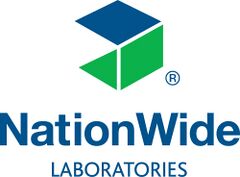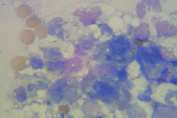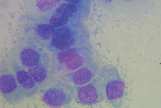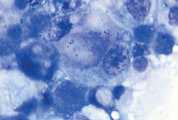Prostate cytology
Introduction
Prostatomegaly, haematuria and voiding of blood from the penis are indications for prostatic cytology and samples may be collected by a prostatic wash or direct aspiration. FNA
of the prostate gland often yields more prostatic cells than other methods of sample collection.
Prostatic wash
- Clean the tip of the penis then, using minimal lubrication, introduce a urinary catheter to the base of the prostate as palpated per rectum
- Apply gentle suction with a 10ml syringe and gently massage the prostate. Release the suction and withdraw the catheter
- Expel any solid material onto a clean glass slide and prepare squash smears (Fig 1). Rapidly air dry
- If bacterial culture is required either expel the sample into a sterile container or express onto a swab, which should then be placed in transport medium. Submit any remaining fluid with 2 drops of formalin in a plain tube
- If insufficient material is obtained by this method then a prostatic wash can be performed.
After introducing the catheter, repeatedly inject and aspirate 2-5ml of sterile saline whilst gently massaging the prostate. Depending upon the gross appearance of the resulting wash, either prepare two air dried direct smears of the wash or prepare two air dried smears of a centrifuge deposit as described below:
Centrifuge 2ml of sample at slow speed (1500rpm) for 5 minutes. Decant the supernatant and resuspend the cell pellet in the small amount of fluid that drains back. Agitate to ensure that the pellet is adequately resuspended. Pipette a drop of the sediment onto one end of a clean glass slide and prepare a squash smear. Rapidly air dry. Submit any remaining fluid with 2 drops of formalin in a plain tube.
Prostatic aspiration technique
FNA is contraindicated in patients with a bleeding disorder, if a prostatic abscess or acute prostatitis is suspected. In cases of abscessation and bacterial prostatitis there may be an increased risk of peritonitis associated with direct FNA and collection of material by prostatic massage/wash is recommended. A trans-abdominal or trans-perineal (peri-rectal) approach may be used. Ultrasound guided aspiration is preferred and allows sampling from localised lesions. If ultrasonography is not available then a blind aspiration technique may be considered for diffuse pathology.
- A 22-23g, 1-1½” needle, with a 10ml syringe attached is required
- Prepare the skin at either site as for any aseptic surgical procedure. Local anaesthesia is likely to be required with the peri-rectal technique
- For a trans-abdominal approach, place the dog in dorsal recumbency. Elevate the prostate with rectal digital palpation to a position close to the caudoventral abdominal wall
- For a peri-rectal approach, pass the needle through the skin in the perineal region and guide to the prostate along a finger in the rectum
- Gently aspirate the gland while moving the needle within the prostate trying not to direct the needle along the same track twice. This can lead to blood contamination
- Prepare smears of the aspirated material and rapidly air dry




